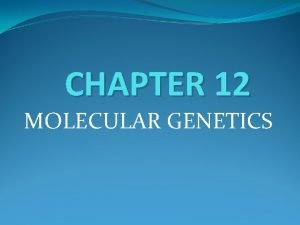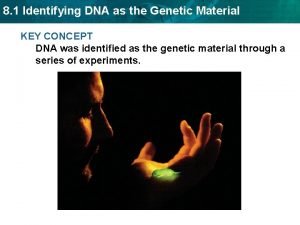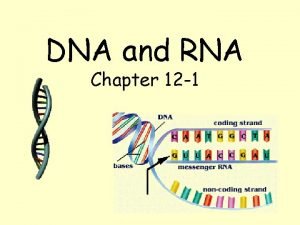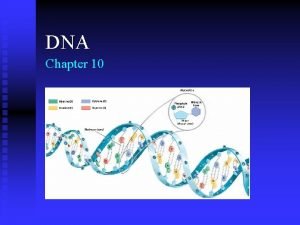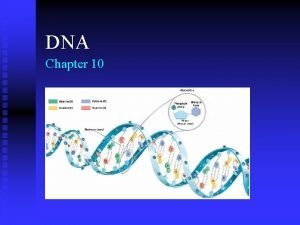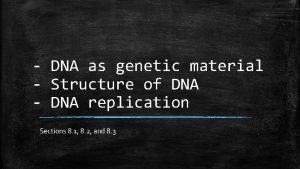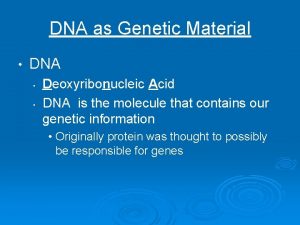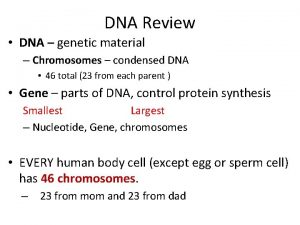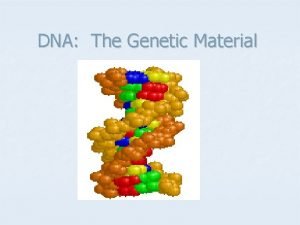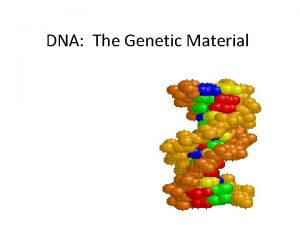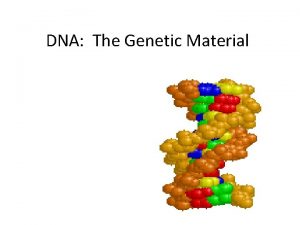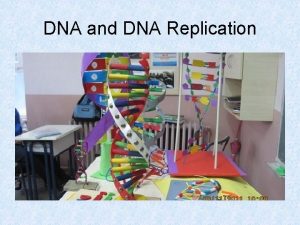DNA THE GENETIC MATERIAL Discovery of Genetic Material












- Slides: 12

DNA: THE GENETIC MATERIAL

Discovery of Genetic Material � Griffith: 1928 � Studied streptococcus pneumoniae, which causes pneumonia � Injected smooth and rough strains of the virus into mouse. � Live smooth strain kills mouse, dead smooth strain does not kill mouse, rough strain does not kill mouse, dead smooth strain mixed with live rough strain kills mouse. � Mixed bacteria taken from dead mouse showed live smooth bacteria This suggests that the disease causing factor was passed from smooth to rough.


Cont. � Avery: 1944 � Isolated protein, DNA, and lipids from killed smooth cells and exposed them to rough cells. � Found that when rough cells were exposed to smooth cells, they became smooth. � Suggested that DNA was responsible and was the genetic material

Hershey and Chase � Hershey and Chase: 1952 � Provided definitive evidence that DNA is the genetic material. � Used a bacteriophage (a virus that attacks bacteria) The virus is not a cell and can’t replicate on its own, it injects it’s genetic material into a host cell. � Isolated the two parts of the bacteriophage (protein and DNA) and found that the DNA was injected into the host cell to replicate the virus.

Hershey and Chase � Radioactive Labeling � They labeled a set of bacteriophages with radioactive phosphorous (no phosphorous in protein, only DNA) so DNA would be radioactive. � They labeled another set of bacteriophages with radioactive sulfur (sulfur is in protein but not DNA) � They then injected the radioactive bacteriophages into the bacteria. Only the bacteriophages injected with phosphorous (radioactivity on DNA) transferred this radioactivity to the bacteria.


DNA Structure � Nucleotides: P. A. Levine discovered that Adenine, Guanine, Cytosine, and Thymine were the nitrogenous “bases” that made up DNA. � Adenine and Guanine are double ringed bases. � Cytosine and Thymine are pyrimidine Single ring) bases

Chargaff � Chargaff: Found that the amount of guanine equaled the amount of cytosine, and the amount of adenine equaled the amount of thymine. This gave us Chargaff’s Rule: �A pairs with T, G pairs with C.

Double Helix � � Now, the structure had to be determined. X-Ray Diffraction � Rosalind Franklin shot X-Rays at DNA and took a picture.

Watson and Crick � Using Franklin’s and Chargaff’s data as well as mathematics (yay math!), Watson and Crick built a model of the double helix that fit the available evidence. � Two outside strands made of dioxyribose (sugar) and phosphate � C and G paired together by three hydrogen bonds � A and T paired together by two hydrogen bonds

Orientation � The phosphate backbone strands of DNA run in opposite directions of each other. One runs 5’ to 3’, the other 3’ to 5’.
 Molecular genetics section 1 dna the genetic material
Molecular genetics section 1 dna the genetic material Section 12-1 dna
Section 12-1 dna Chapter 12 section 1: dna: the genetic material
Chapter 12 section 1: dna: the genetic material Section 1 identifying dna as the genetic material
Section 1 identifying dna as the genetic material Chapter 12 molecular genetics answer key
Chapter 12 molecular genetics answer key On and off
On and off What type of rna
What type of rna Section 10-1 review discovery of dna
Section 10-1 review discovery of dna Gene flow vs genetic drift
Gene flow vs genetic drift Genetic drift founder effect
Genetic drift founder effect Genetic drift vs genetic flow
Genetic drift vs genetic flow Genetic programming vs genetic algorithm
Genetic programming vs genetic algorithm Genetic programming vs genetic algorithm
Genetic programming vs genetic algorithm

